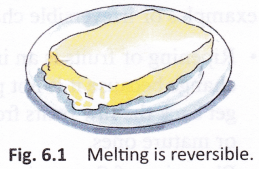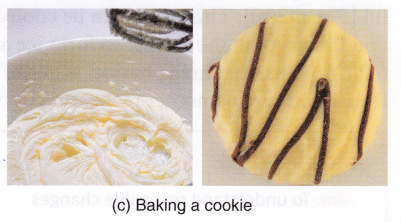REVERSIBLE AND IRREVERSIBLE CHANGES
Changes that occur around us can be broadly categorized as reversible or irreversible depending on whether or not they can be reversed.
Reversible Changes
Changes that can he reversed are called reversible changes.
What happens to an ice cream if you do not finish it quickly? It melts. Can you change the molten ice cream back into a solid? Yes! Just keep it in the freezer. Molten ice cream can be changed back to its solid form. Thus, melting is a reversible change. Melting of butter and chocolate are also reversible changes.

What about changes like condensation, freezing, and evaporation of materials? If you take out some ice cubes from the freezer and keep them outside, the ice cubes will absorb heat from the surrounding and melt. When this water (molten ice) is heated for some time, it starts boiling (liquid starts to evaporate) and steam escapes from the container.
 Now, if you hold a lid over the container, the steam will again liquify or condense into small droplets of water on coming in contact with the cold lid. This water can be cooled down further and then kept in the freezer to form ice again. Thus, the three physical states of water are reversible and can be changed from one state to another by heating or cooling.
Now, if you hold a lid over the container, the steam will again liquify or condense into small droplets of water on coming in contact with the cold lid. This water can be cooled down further and then kept in the freezer to form ice again. Thus, the three physical states of water are reversible and can be changed from one state to another by heating or cooling.
Irreversible Changes
Changes that cannot be reversed are called irreversible changes.
There are a large number of irreversible changes that take place around us. These result in a new material being produced, which may or may not be useful. Some examples of irreversible changes are given below.
- Ripening of fruits is an irreversible change because it is not possible to get back the raw fruits from ripened or mature ones.
- Blooming of flowers is an irreversible change because flowers cannot change back into buds.

- Milk gets spoiled when not refrigerated, particularly in summer. This is called curdling or souring of milk, which is an irreversible change. Curdling of milk is also done by adding lemon juice to milk for making cottage cheese or paneer.
- Burning of paper is an irreversible change. A new substance called ash is left or formed after a paper has been burnt. This new substance differs from the paper in its appearance and properties.

- Cooking of food is an irreversible change because we cannot get back the ingredients in their original form after cooking them. For example, after a cake is baked using flour, egg, milk, chocolate, etc., we cannot get back the ingredients.

Burning of a candle is often cited as an example of physical change because what we see immediately is melting of wax that solidifies on cooling. However, when a candle burns, the wax is undergoing two changes at the same time: first it melts, and then it burns. What burns is actually melted wax. The melted wax burns on the wick – the wick itself isn’t burning, it is just the wax on it.
Activity
Aim: To understand reversible changes
Materials needed: A balloon, dough, roller pin, and a sheet of paper
Method:
- Blow the balloon. Now, release the air. Does it come back to its original shape and size?
- Take some dough and make a ball. Roll it out. Can you change it back to the ball of dough?
- Fold the sheet of paper to make a toy aeroplane. Can you get back the same paper by unfolding the aeroplane?
Conclusion: All the above changes are reversible.
